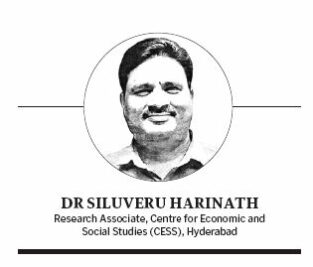Opinion: Bridge student-teacher ratio
While it is a good sign that government schools are in demand, shortage of teachers needs to be addressed

Dr Siluveru Harinath
Hyderabad: The school education sector in the country, though moving forward, is facing many challenges. A UNESCO-led report on ‘State of the Education Report (SOER) for India: in 2021’ revealed that the country is in dire need of infrastructure as well as human resources. According to the report, 94.30 lakh teachers are imparting education to the 24.83 crore students studying in 15.51 lakh schools in the country. Besides, 7% of the total schools are single-teacher schools.
Overall, both in private and government schools, the number of teachers increased 17% during the academic years of 2013-18. However, it is interesting to note that the number of teachers in private schools has increased 14%, but that in government schools has been declining every year.
Right to Education
According to the Right to Education Act, the student-teacher ratio in schools is 26:1. But in the current circumstances, the student-teacher ratio is short by 10% in private schools and 6% in government schools. It is a matter of concern that there is a shortage of teachers mainly in primary schools which are the foundation for higher studies. Primary schools must have proper faculty to teach subjects like mathematics, science, social and languages. But the lack of such subject teachers makes it clear that the quality of education is not up to the mark.
According to the School Education Quality Index released by the NITI Aayog in 2019, only 30% of eighth grade students in the country were proficient in mathematics. This indicates how the learning levels of the students are declining due to the shortage of subject teachers. It is the responsibility of the respective State governments to expedite the process of filling teacher posts regularly without any delay. But the majority of the schools are functioning with Vidhya Volunteers as well as contract teachers.
The Right to Education Act, as well as Article 21 of the Constitution, is intended to provide a dignified life for all children. But the ruling governments have not been able to take adequate measures to fully implement those laws. Resultantly, 5.3% of children between 6 and 10 years old are still out of school, as per the ASER 2020 report.
Weakening System
How can the education system be strengthened without such teachers in schools? Governments in many States, however, tend to weaken government schools and do not take any steps to strengthen them. This is evidenced by the fact that there are still more schools that are functioning with single teachers. The acute shortage of teachers in about 19% of schools in the country shows how the State governments are weakening the education system. Given this, one can understand how the teaching is taking place in 21,077 schools in Madhya Pradesh and 17,683 schools in Uttar Pradesh with a single teacher.
Rising Vacancies
UNESCO in its report pointed out that the current proportion of students in schools across the country would require about 11.16 lakh teachers more. The highest number of teacher vacancies is found in Uttar Pradesh with 3.23 lakh, followed by Bihar (2.22 lakh), Madhya Pradesh (87,630) and West Bengal (84,912). Telangana had 37,204 vacancies and Andhra Pradesh, 27,398.
As per the latest National Crime Record Bureau 2020 statistics, the youth of Uttar Pradesh and Bihar are at the forefront of criminal history, committing more robberies – an adverse affect of undermining school education systems.
Besides, many States fail to fill teacher vacancies through direct recruitment. In Mizoram, Odisha, Madhya Pradesh, Punjab and Jharkhand, new recruitments do not take place till special appointments or promotions are given to those working in such schools. Thus, the school administration is forced to take the services of Vidya Volunteers.
It can also be said that the authorities concerned are indirectly responsible for the increase in the educational business of private schools. On the other hand, many educated people are refusing to enter the teaching profession due to a lack of regular recruitment for many years.
Govt Schools
Due to the pandemic many low-budget private schools in rural areas had shut. The students from such schools, therefore, are coming forward to join government schools. In Haryana, for example, there were 20 lakh students in government schools last year, but that number has increased to 25 lakh this year. In comparison, 5 lakh students have increased in this academic year.
Similarly in Telangana, over 2.5 lakh students have additionally enrolled in government schools, and many more are join in the coming days. This is likely to place a heavy burden on current faculty. Hence, there will be a need for additional teachers. While this is a good sign for government schools as they see resumption, it is the responsibility of the authorities to strengthen these schools without eroding the confidence of students.


Related News
-
Telangana government allows school students’ tour to Ramoji Film City amid past outing restrictions
-
Thailand reports first civilian deaths in renewed border conflict with Cambodia
-
Deepavali added to UNESCO’s Intangible Cultural Heritage list
-
9th Pariksha Pe Charcha to be held in January 2026; registrations open till Jan 11
-
Centuries and fiery spells highlight HCA Inter-school U-14 cricket in Hyderabad
12 mins ago -
Sumit Nagal wins golden-point thriller as AOS Eagles shine in Bengaluru
16 mins ago -
India eye strong finish in final T20I against South Africa in Ahmedabad
23 mins ago -
BRS complaints of foul play over Neelibanda thanda Sarpanch election results
26 mins ago -
Ishan Kishan powers Jharkhand to maiden Syed Mushtaq Ali Trophy title
31 mins ago -
Cummins and Lyon put Australia on top in Adelaide Ashes Test
33 mins ago -
India expands e-visa facility, covers 171 nations
34 mins ago -
Satwik-Chirag beat Alfian-Fikri to lead Group B at World Tour Finals
36 mins ago




